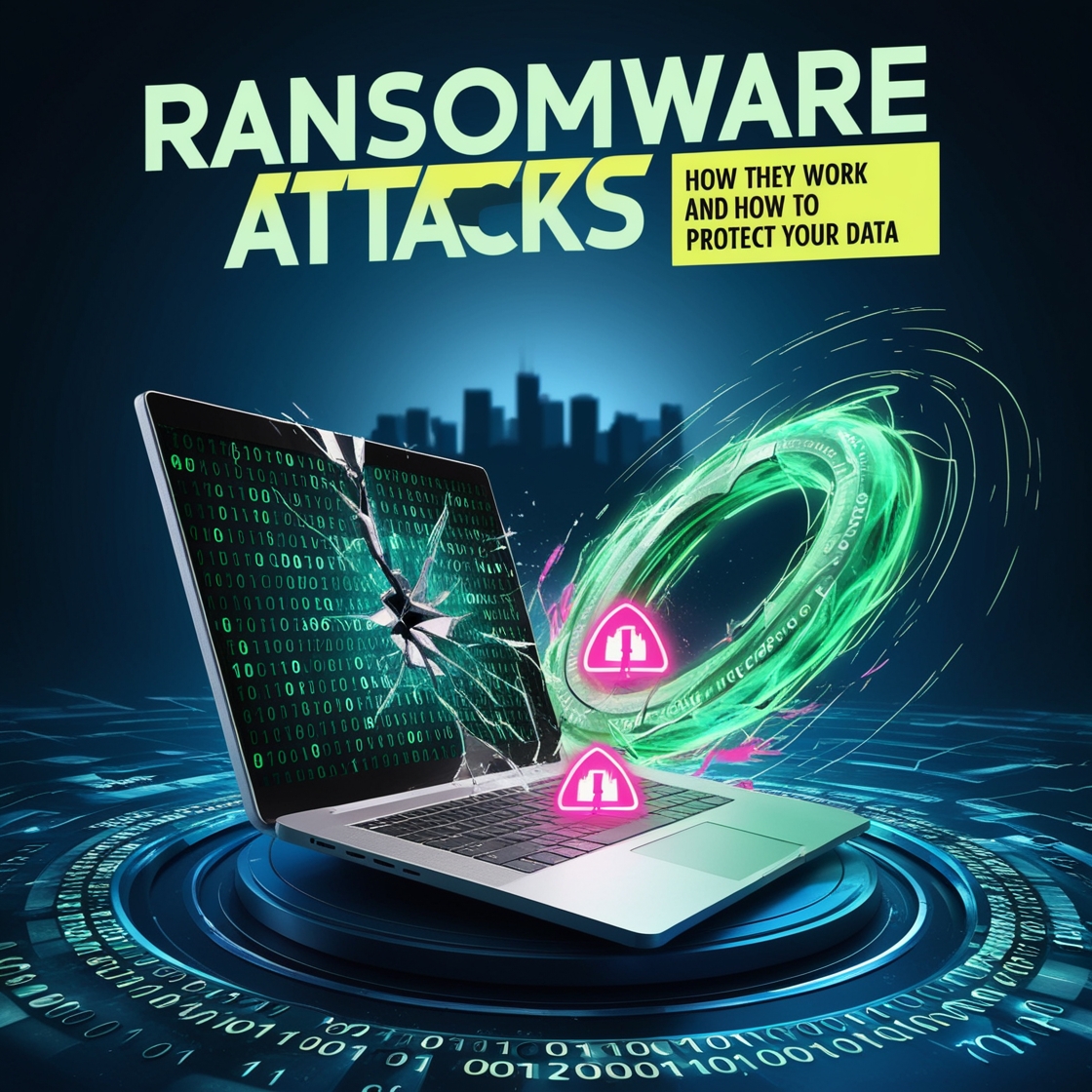Introduction
Ransomware attacks are now among the most dangerous and financially damaging cyber threats facing individuals and organizations alike. As digital dependency grows, ransomware incidents increase, impacting everything from personal data security to major organizational infrastructure. Understanding how ransomware works and knowing how to protect yourself are essential first steps toward keeping your data safe.
What is Ransomware?
Ransomware is a type of malware that locks or encrypts data on a system, demanding a ransom from the victim to regain access. Unlike other forms of malware, ransomware specifically aims to extort money from users or organizations by holding essential data hostage.
- Types of Ransomware:
- Crypto Ransomware: Encrypts files, making them unreadable without a decryption key.
- Locker Ransomware: Locks the user out of the entire system but doesn’t typically alter files.
How Ransomware Attacks Work
Ransomware attacks follow a series of stages, generally beginning with infiltration, where the malware gains access to a network or device, often through phishing or malicious downloads. Once inside, the ransomware quickly spreads to other parts of the system, encrypting files and creating ransom notes. Attackers frequently use social engineering to exploit human weaknesses, making users more susceptible to downloading the malicious software.
Types of Ransomware Attacks
- Crypto Ransomware: Encrypts files, demanding ransom for the decryption key.
- Locker Ransomware: Locks access to the device itself, restricting all access.
- Ransomware as a Service (RaaS): Available for rent on the dark web, allowing non-experts to conduct attacks.
- Double Extortion: Attackers demand ransom, then threaten to leak stolen data if not paid.
Common Ransomware Delivery Methods
Ransomware typically enters systems through one of the following methods:
- Phishing Emails: Phishing attacks trick users into clicking malicious links or downloading attachments that install ransomware.
- Malicious Downloads and Attachments: Downloads from untrustworthy sites often carry ransomware.
- Social Engineering Tactics: Manipulative tactics that convince users to lower their guard.
- Exploiting Software Vulnerabilities: Outdated software with security gaps is an easy entry point.
Signs of a Ransomware Attack
Early detection can be crucial in limiting damage. Some common signs include:
- Unusual Computer Behavior: The system becomes slow, files are inaccessible, or there are unusual error messages.
- Encrypted Files: Extensions change, and file access is blocked.
- Ransom Messages: Messages appear demanding payment to unlock data.
The Costs of Ransomware Attacks
Beyond ransom payments, ransomware attacks have far-reaching impacts, including:
- Financial Costs: Recovering from ransomware can cost millions, with significant losses in revenue.
- Reputational Damage: Customers may lose trust if sensitive data is compromised.
- Operational Losses: Downtime due to attack recovery can disrupt services and productivity.
Examples of High-Profile Ransomware Attacks
Ransomware has affected major institutions worldwide. Notable examples include:
- WannaCry: Spread globally, affecting healthcare, finance, and more.
- NotPetya: Targeted Ukraine initially, but had worldwide effects.
- Colonial Pipeline Attack: Caused fuel shortages across the U.S.
- Healthcare Sector Attacks: Hospitals and clinics, holding sensitive patient data, are frequent targets.
Why Organizations are Prime Targets
Sensitive data and financial assets make organizations appealing to cybercriminals, especially if their cybersecurity practices are weak. Large companies are often more willing to pay the ransom due to the potential costs of disrupted operations and data exposure.
How to Protect Your Data from Ransomware
Proactive measures can minimize the risk of falling victim to ransomware:
- Maintain Regular Backups: Regularly backup data to external, disconnected sources.
- Implement Multi-Factor Authentication (MFA): Protect accounts with extra layers of security.
- Install Antivirus and Anti-Malware Software: Reliable software can detect threats before they cause harm.
- Employee Training on Cybersecurity Awareness: Educate employees on phishing and safe online behavior.
- Regular Software Updates and Patch Management: Keep all software updated to prevent exploitation.
The Role of Cyber Insurance
Cyber insurance can help organizations manage the aftermath of ransomware by covering potential recovery costs. However, insurance coverage depends on the policy details and may not always cover ransom payments.
Steps to Take If You’re a Victim of Ransomware
If you detect ransomware, follow these steps:
- Isolate Infected Systems: Disconnect the device from the network to prevent further spread.
- Report the Attack: Inform authorities and relevant cybersecurity organizations.
- Assess the Extent of Damage: Determine what data or systems were affected.
- Seek Professional Help: Engage a cyber incident response team for expert support.
Should You Pay the Ransom?
Paying the ransom may seem tempting, but it isn’t always advisable. Paying does not guarantee full data recovery and could encourage further attacks. Instead, focusing on preventive measures can offer better long-term protection.
The Future of Ransomware
Ransomware tactics are evolving, with criminals developing advanced techniques. As technology advances, the focus on developing stronger cybersecurity defenses will only grow.
Conclusion
Ransomware is a potent threat that requires constant vigilance and proactive measures. From regular backups to employee training, prioritizing cybersecurity can greatly reduce your risk.
FAQs
- What should I do if I receive a ransomware message? Disconnect from the internet, avoid paying, and contact a cybersecurity professional.
- Are small businesses safe from ransomware? No, small businesses are frequent targets due to weaker defenses.
- Can ransomware be removed without paying the ransom? In some cases, yes. Professional help can sometimes decrypt data without a ransom.
- How long does it take to recover from a ransomware attack? Recovery can take days to months, depending on the extent of the attack.
- What industries are most affected by ransomware? Healthcare, finance, and government sectors are among the most targeted
